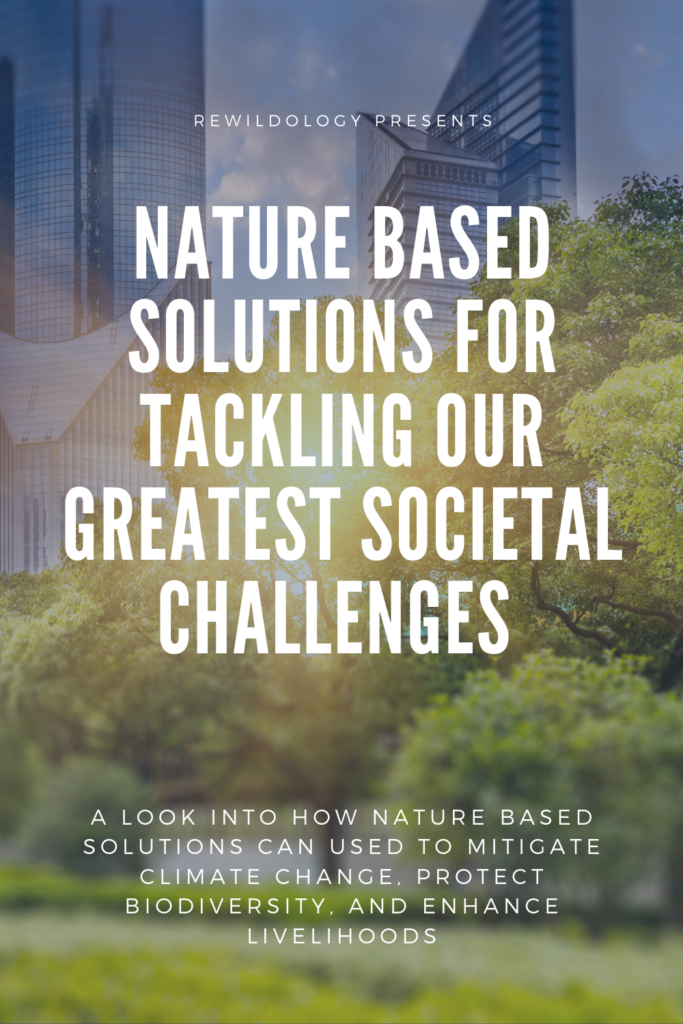At this point in 2021, we’re all well aware that we need to make drastic changes on a societal level if we’re going to combat climate change, halt biodiversity loss, and increase people’s quality of life.
While many past initiatives were implemented with the best intentions, most fell short of their promises.
Global temperatures are still rising; weather patterns are becoming more extreme and unpredictable; food security is anything but; and ecosystems are collapsing at alarming rates.
Setting aside pieces of land for sake of conservation isn’t enough anymore.
We need a new way of thinking, a fully comprehensive solution to societal problems, and we might have just that: Nature Based Solutions (NBS) for society’s biggest challenges.
What are Nature Based Solutions?
According to the IUCN (International Union for Conservation of Nature), Nature-based Solutions (NBS) are “actions to protect, sustainably manage, and restore natural or modified ecosystems, that address societal challenges effectively and adaptively, simultaneously providing human well-being and biodiversity benefits”. (1,3)
Phew, that was a mouthful. I’ll translate.
Nature based solutions leverage natural processes to comprehensively solve society’s biggest issues. In other words, NBS work with nature, not against it.
NBS are relatively new in the conservation and sustainability fields. Even though ecosystem services have always been recognized by indigenous societies as integral contributors to human wellbeing, the term wasn’t coined by scientists until the 1970s when it was finally understood that natural processes are imperative for human health (3).
The acceptance and eventual promotion of NBS came to be when massive organizations, including the World Bank and IUCN, went scouring the globe looking for solutions to society’s greatest challenges that complemented nature and its processes, instead of solely relying on modern-day engineering. And unlike other forms of conservation, NBS also strive to create sustainable livelihoods for communities, which tends to be left out of conservation planning. (3)
These last two features of NBS is critical, as only 40% of urban areas that will exist in 2030 are currently present, meaning a crap ton of infrastructure has yet to be built (6). Designing blue and green cities will be vital for halting future biodiversity loss and managing climate issues. (4)
You all know how hot and stuffy downtowns can be. Now just imagine going to Las Vegas in August if the temperature continues to rise.
We’ll get into specific case studies in a minute, but example NBS include restoring coral and mangrove ecosystems to protect cities from devastating flooding, restoring and conserving local forests to manage water flow and increase food security, and building green infrastructure to improve air quality, reduce pollution, and increase city aesthetics. (3, 7)
After hearing all of this, you may be thinking to yourself, “Cool, Brooke, same song, second verse. How can Nature based Solutions tackle the issues we’ve been trying to solve for decades?”
Great question.
NBS are distinctly different from classic conservation strategies, as they’re specific to the location and issue in question and involve all stakeholders. They can be developed as a new solution all together (i.e. green infrastructure in cities), in conjunction with existing conservation projects (i.e. restoring fish stocks in a protected wetland for increased food security), or to sustainably manage restored ecosystems and increase people’s livelihoods (3).
How exactly are NBS different from conservation? Conservation’s main function is to protect and preserve biodiversity and ecosystems, which has led to the creation of national parks, protected areas, and environmental laws. Conservation does not address sustainable livelihoods or the people that live with wildlife. Its sole purpose is to protect nature for the future. (7)
NBS are also distinctly different from the emerging rewilding movement. The process of rewilding ecosystems is just that – us getting out of the way and letting nature restore ecosystems with little to no human intervention other than removing damaging infrastructure and reintroducing species. (8)
Case Studies
Okay, so we now know that NBS are different from classic conservation strategies and rewilding, so what are some examples of NBS in action?
First, let’s chat about a project in my backyard.
Restoring Cache la Poudre River in Fort Collins, Colorado, USA
I recently moved to a northern suburb of Denver, about 45 minutes from Fort Collins. For my husband’s birthday, I bought us new and improved bike gear to explore the Poudre Trail along the Cache la Poudre River and go brewery hopping until we decided we had reached our limit for tasty craft beer and good food. I had never biked in Fort Collins before and while planning the trip, I was immediately impressed by the length and accessibility of the Poudre Trail. Little did I know that this trail was part of a massive project to restore riparian ecosystems, control damaging seasonal floods, increase biodiversity, enhance resident’s lives, and create a greener and bluer Fort Collins.
The project had many moving parts. Dams and concrete riverbanks were removed; the river was reconnected with its floodplains; native vegetation and trees were planted along the river to reestablish healthy riparian ecosystems; wetlands were restored, and so much more. Businesses also experienced a boost in profits and we were the perfect example. I wouldn’t have chosen that activity for Lee’s birthday shenanigans if the trail wasn’t there. (3, 9, 10)
Restoring Forests in Rwanda
The next case study hops across the globe to the famous gorilla-trekking destination, Rwanda.
Proceeding the 1994 genocide, Rwanda experienced a population boom that subsequently put a ton of pressure on natural resources. Forests were felled to make way for agriculture, the country’s main livelihood, and wood for cooking fuel. Biodiversity, water and food security, and soil quality significantly decreased, while erosion and pollution saw an equal increase. To address this alarming new state of affairs, the Rwandan government launched The National Forest Policy in 2015 to restore natural and manmade forests.
Check out these very exciting targets from Vision 2020 listed in the 2018 National Forest Policy:
“Target 5: The rate of loss of all natural habitats, including forests, is at least halved and where feasible brought close to zero, and degradation and fragmentation are significantly reduced.
Target 7: Areas under agriculture, aquaculture and forestry are managed sustainably to ensure conservation of biodiversity.
Target 14: Ecosystems that provide essential services, including services related to water, and contribute to health, livelihoods and well-being, are restored and safeguarded, taking into account the needs of women, indigenous and local communities, and the poor and vulnerable”
The project has been wildly successful. Restoring the forests has provided local communities with forestry and agroforestry jobs, aligning with poverty-alleviation strategies. Food security has also improved from sustainable agricultural practices.
In 2019, Rwanda announced that they had reached their restoration goal of 30% total forest land coverage a year ahead of schedule! They’re on pace to reach their 2 million hectare pledge to contribute to the Bonn Challenge. This challenge was launched in 2011 and set a worldwide goal of restoring 150 million hectares of forests. (11, 12, 13, 3)
I didn’t successfully find a status update on Vision 2020, but I’ll be sure to share it once it’s available.
Not a Silver Bullet
So, this has been awesome so far, but where is the catch? Should we use NBS in all situations for mitigating climate change and creating sustainable livelihoods?
While NBS are certainly powerful, they are not silver bullets. In some circumstances, solving an issue through NBS is not the best option or onr may be simply a great complimentary solution to an existing project (2, 5).
NBS especially do not negate the immediate need for governments and industries to drastically reduce their carbon footprint to combat climate change. While forest restoration is fantastic for carbon sequestration, it will not reverse the effect of millions of metric tons of carbon being released into the atmosphere.
I really like the way WWF Lead Scientist, Jeff Opperman, put it. Just like you’d never put all of your money into one stock, we shouldn’t rely on one solution for climate change. We need to diversify our climate mitigation strategies and create a robust portfolio, which NBS accomplish (5).
Your Voice Matters
No matter if you’re a community member or a business owner, become involved in projects that utilize NBS.
See what ideas are being proposed in city council meetings and at the voting polls, then let your voice be heard in support. Remember, you are a global citizen and stakeholder in your community.
Your voice matters.
If you agree that NBS are a great way to green our cities, enhance people’s lives, and combat climate change, then see what you can do to support or propose a NBS in your area.






